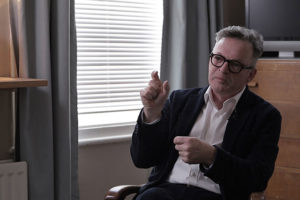Music and Stress
Psychoneuroimmunologist Daisy Fancourt on the use of music in healthcare and its role in emotion regulation
I want to talk a little bit about the possible future for the use of psychedelic drugs in psychiatry. The history of the use of psychedelics in western medicine is pretty short and pretty disastrous. It started in 1943 when the properties of LSD, lysergic acid diethylamide, were discovered by Albert Hofmann, who worked for the Sandoz drug company in Switzerland. He was investigating the effects of the plant extracts called ergots and he synthesized this compound which he managed to get on his fingers during the process of synthesis. He noticed strange subjective sensations and he was smart enough to realise that it was pretty unusual. He was curious about what it was, so he got a synthesis of this compound and he deliberately administered 250 micrograms to himself. So he was the first person in Western society to take LSD as pure LSD. He then attempted to cycle home for lunch and it was an interesting ride: it’s sometimes called ‘the bicycle day’. During that day he experienced all the extraordinary visual subjective sensations associated with an LDS trip, as it came to be called.
He was immediately amazed by the implications of this, and others, who read about it, were also incredibly interested by what he discovered because what he was showing was that you could profoundly change perception and the mind with a dose of the drug in the microgram range. Prior to this, drugs that acted on the brain had really been thought as of depressants, drugs that essentially would be present in milligram amounts at least and their mechanism of action was not at all understood. In fact, at the time we didn’t really understand that brain cells communicate with each other through chemistry. So this was a finding way ahead of its time in some ways, it was a major stimulus to the most basic neuroscience. People then went on to discover compounds called monoamines which are analogous to LSD: LSD works on the receptors that are naturally occurring for these neurotransmitters, particularly serotonin.
In addition, there was an interest for clinical application. This is, we’re talking about 1947, as early as that. Sandoz made LSD available for selected psychiatrists to use in psychiatric patients. In those days there was very little regulation, so doctors were pretty free to try things out and report back. They did that on a very remarkable scale in the 1950s: it was mainly with LSD but other drugs then came along. It was also realized that there was a big tradition in the use of these sorts of drugs, plant extracts, in a number of indigenous societies across the world, particularly in South America. That led to the discovery of other drugs like mescaline, from the peyote cactus and psilocybin from mushrooms, ‘magic mushrooms’ as they are sometimes called. Magic mushrooms grow all over temperate climates, for example, in Europe so they’re present, there with us all the time. These compounds all have in common that they bind to this group of receptors, called 5-HT2A receptors, in the brain and therefore they work on serotonin pathways. This was established relatively recently but it was the stimulus to basic neuroscience that got us going, initially.
What happened to the clinical application if it was so widespread? About 40,000 patients were probably treated and it was regarded as a way of facilitating psychotherapy at the time. The problem was that this was before the time when psychiatrists really thought carefully about the objective properties of the illnesses they were looking at. That didn’t really start until the 1980-s. So the psychiatrists used very vague descriptions and they used, in order to understand the effects, terms that derived from psychoanalysis which we now find a little confusing and ambiguous. That for us is a limitation of understanding what was actually happening in the 1950-s and reading the literature of the time.
If we’d simply continued to use the drug there would have been the possibility to understand better which patients it was best for, how good it was for them, what the long-term outcomes were. But unfortunately other things happened: the widespread use, particularly of LSD but also of other drugs, in what was called the counterculture in the United States in the 1960s. That resulted in a kind of moral panic around the use of these drugs by young people. The fact that this was resulting in a tremendous social schism and it also fed very much into issues around the Vietnam War, which was tremendously divisive in the United States. It pitted the younger generation against older people and the use of drugs became a symbolic way of rubbing in the difference, so it became a political worry. So the politicians, as they usually do, resorted to law to try to prevent things and they made the drugs illegal. And when the United States makes drugs illegal other countries basically through treaties usually have to follow, and that’s effectively what happened.
So in 1970 LSD and similar compounds were classified as highly dangerous drugs that were illegal. And an illegal drug is something that a person could use illegally but it’s not something a doctor can use legally, by definition. So, doctors, researchers could really no longer use the drug for human experimentation or human treatment studies. Essentially the whole thing went underground. People in America continued to use these drugs to assist psychotherapy but it was essentially outside the law, it was outside formal reporting procedures, it was unregistered. So in a sense, we lost these important compounds for many many years. Two generations kill interest in anything.
So that was a position we were in by the 2000-s: about that time people started to get interested again. In the last 10 years, people have applied to do clinical research studies, scientific studies on these drugs under controlled conditions using modern measurements and we have started to try and rediscover them and also rediscover their potential uses. To cut a very long story short, there have now been at least two trials which have been reasonably well controlled: there has been a kind of placebo condition which allows you to say what the effects of the active treatment are, versus no treatment or minimal treatment. What seems to occur is that, in patients particularly with depressive symptoms, there is a good long-term outcome over many months of treatment with a single dose of particularly psilocybin. Psilocybin is emerging as the hallucinogen of choice because it’s a probably gentler experience than LSD, it doesn’t last as long, so it fits into the working day. It’s now relatively easy to synthesise, so it’s available, you don’t have to get it from mushrooms, you can get it in a pure form. A great risk with the illegal drug is that you don’t know what you’re taking.
So what we’re moving to is an era where we will look much more carefully (with psilocybin probably first) what their properties are for treating patients particularly with mood disorders. The interesting part of the story is that the initial studies were done in people who were depressed or anxious because they had terminal cancer. The idea was that their existential distress about their life soon ending would be the thing that was influenced by the drug, so the drug would give you this mystical experience, that mystical experience would make you reevaluate your life and death and in a sense make it more bearable. That’s pretty much what people described but it’s also very much what people expected. What was a little less predictable was that depressive symptoms were so clearly treated.
So what has now happened is that we’ve gone on to look in patients with treatment-resistant depression who don’t have an existential crisis, so they’re not in a position where their life is going to end, but they are often in a position where their life has become totally miserable and worthless. The question is, does this drug reestablish some kind of function? In the first twenty patients that were treated in London at Imperial College, there was a surprisingly good response and in some of those patients, a transformational response, when taking a full dose of psilocybin and then following up for at least a year. I met three of those patients, the three who probably had the best responses and it’s most impressive to talk to them. They have very long and complicated histories; they had got to the end of the line, they were really contemplating suicide, they thought their lives were really worthless. They have been turned around by the experience with this drug.
That’s not game set and match for any compound: you have to do fair comparisons between an active treatment and perhaps the standard treatment or no treatment at all. Those studies are now starting to be done. But we seem to be on the verge of a new era in which we take these important drugs seriously, use them under clinical settings and we may be able to remedicalise them. The big risk we face is whether remedicalising will reintroduce them into free-range where people use them for recreational purposes. The difficulty with that is that these drugs are dangerous when people take them in the wrong setting, with the wrong people and in the wrong circumstances. Really-really bad things can happen. That was part of the original moral panic as well as the political implications of drug use, and it remains a valid concern which we’ve got to take very seriously.
So the challenge for our society is, are we now going to simply reestablish this for medical implications and, if we are going to do that, what are we going to do about recreational indication? Because all the experience with cannabis suggests that you start with the medical indication but you end up with a much wider recreational legality which is happening all over North America. We’re not sure that this is really a great idea for the society at large. That’s where we sit at the moment, we sit at an interesting point: we await the results of definitive trials that will show the usefulness of psilocybin and other hallucinogens particularly with difficult to treat depression but we’re unsure how we’re going to take this forward maintaining a medical cocoon of safety, while at the same time recognizing that people may claim the right to make these drugs a recreational choice. It’s going to be an interesting social and political challenge to get this right.

Psychoneuroimmunologist Daisy Fancourt on the use of music in healthcare and its role in emotion regulation

Biomedical engineer James Collins on bacterial persisters, mammalian metabolism, and antibiotics

Professor of Neurology Kevin Talbot on genome editing in neurodegenerative diseases, their genetic causes and ...